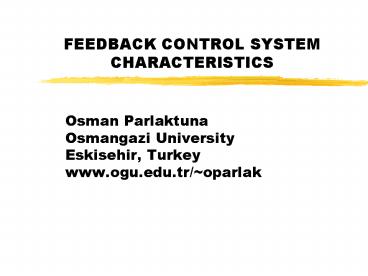FEEDBACK CONTROL SYSTEM CHARACTERISTICS PowerPoint PPT Presentation
1 / 16
Title: FEEDBACK CONTROL SYSTEM CHARACTERISTICS
1
FEEDBACK CONTROL SYSTEM CHARACTERISTICS
- Osman Parlaktuna
- Osmangazi University
- Eskisehir, Turkey
- www.ogu.edu.tr/oparlak
2
OPEN-AND CLOSED-LOOPCONTROL SYSTEMS
- An open-loop system operates without feedback and
directly generates the output in response to an
input signal. - A closed-loop system uses a measurement of the
output signal and a comparison with the desired
output to generate an error signal that is
applied to the actuator.
3
R(s)
Ea(s)
R(s)
C(s)
C(s)
G(s)
G(s)
Open-loop control system
H(s)
Closed-loop control system
C(s)G(s)R(s)
4
Sensitivity to Parameter Variations
- A process, represented by G(s), is subject to a
changing environment, aging, ignorance of the
exact values of the process parameters. In the
open-loop system, all these errors and changes
result in a changing and inaccurate output. - However, a closed-loop system senses the changes
in the output due to process changes and attempts
to correct the output. - Consider a change in the process as
In the open-loop case, the change in the output
is
In the closed-loop system
5
The change in the output of the closed-loop
system is reduced by a factor 1G(s)H(s)2,
which is greater than one over the range of
frequencies of interest.
System Sensitivity Ratio of the percentage
change in the system transfer function to the
percentage change of the process transfer
function.
In the limit, for small incremental changes
Clearly, sensitivity of the open-loop system is
equal to one.
6
Result Sensitivity of the system may be reduced
below that of the open-loop system by increasing
G(s)H(s) over the frequency range of interest.
The sensitivity of the feedback system to changes
in the feedback element H(s) is
When GH is large, the sensitivity approaches
unity and the changes in H(s) directly affect the
output. Therefore it is important to use feedback
components that will not vary with environmental
changes.
7
DISTURBANCE SIGNALS IN A FEEDBACK CONTROL SYSTEM
A disturbance signal is an unwanted input signal
that affects the systems output signal. As a
steel bar approaches the rolls, the rolls turn
unloaded. However, when the bar engages with the
rolls, the load on the rolls increases
immediately to a large value. This loading effect
can be approximated by a step change of
disturbance torque.
Rolls
Conveyor
8
The error for the system is E(s) R(s)-w(s) and
R(s)wd(s). For simplicity in calculation, let
R(s)0, and examine E(s)-w(s).
The change in speed due to the load disturbance is
9
Td(s)
Amplifier
Va(s)
Speed
Km Ra
Tm(s)
TL(s)
1 JsB
Ka
W(s)
Kb
Tachometer
Kt
Closed-loop speed control system
10
When the amplifier gain Ka is sufficiently high,
11
The Cost of Feedback
- Increased number of components and complexity.
- Loss of gain Open-loop gain is G(s) and is
reduced to G(s)/(1G(s)) in a unity negative
feedback system. We may need an amplifier to
increase the gain of the feedforward path. - Possibility of instability. Whereas the open-loop
system is stable, the closed-loop system may not
be always stable.
12
EXAMPLE
Plot the unit-step input response and response to
unit-step disturbance of the system For i) K50
and ii)K100. Compare the results.
D(s)
R(s)
E(s)
C(s)
K
13
Disturbance response for both K values is
acceptable, but step-input response has less
overshoot for K50 and the settling time is one
second. For K100, overshoot is greater and
settling time is about 0.65 seconds.
14
D(s)
Compare the open-loop and closed-loop control
systems for i) sensitivity relative to K ii)
Unit-step disturbance
C(s)
Open-loop control of Mars Rover
D(s)
C(s)
R(s)
K
Closed-loop control of Mars Rover
15
For K2,
Hence we can compare the sensitivity of the
open-loop and closed-loop systems for the same
transfer function.
To examine the effect of the sensitivity at low
frequencies, let sjw
For K2, the sensitivity at low frequencies,
wlt0.1 is
16
The effect of disturbance can be determined by
setting R(s)0 and letting D(s)1/s. For the
open-loop system, the steady-state value is
The output of the closed-loop system with a unit
step disturbance is
For K2,

